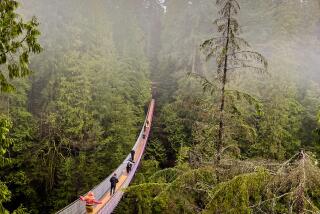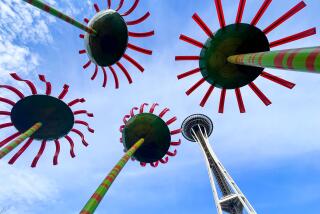Battling the cruise ship bulge
- Share via
From our well-earned vantage point atop a granite outcropping 2,000 feet above Alaska’s glacial passages, we looked down to our flotel, the floating hotel that had become a refuge from the howling wilderness. Soon we would be warming our aching muscles in the topside whirlpool — an impeccable conclusion to a day of hiking along the Inside Passage.
My wife and I had heard an Alaskan cruise was only for “the newly wed or nearly dead.” Kimi and I, active people in our robust middle years, were daunted by this generalization and others — including the assumption that a constant onslaught of super-caloric food would be served while we did little more than sit on our duffs watching the landscape slide by.
We don’t have anything against good food. We just need to earn our indulgences.
So when our travel agent suggested we join the maiden voyage of the Radisson Seven Seas Mariner three years ago, we signed on but made a vow: We wouldn’t gain a pound by the end of the trip.
Our strategy was to get off the ship the moment we made port and hit the nearest trailhead for a vigorous hike so we could feel virtuous enough to indulge in the Mariner’s gourmet fare. That’s important, because on the Mariner, it’s hard not to rest, relax and indulge.
Every cabin is a suite with a balcony, and the living space ranges from about 250 to 1,200 square feet. (The latter, a two-bedroom suite, also has almost 800 square feet of veranda space.) Our accommodations were more extravagant than our first house. We also were pleasantly surprised by how comfortably the Mariner can ensconce 700 passengers, offering plenty of privacy.
Midnight departure
We departed at midnight from Vancouver, Canada, under the Lion’s Gate Bridge, leisurely wending our way to Victoria by dawn on an otherwise dreary day. With little time to prepare a hiking itinerary before boarding, we had relied on the Mariner’s library of Alaska guides and Internet access in the ship’s library.We zeroed in on 3,500-acre East Sooke Regional Park, a leisurely hourlong drive from Victoria, and its stunning 6-mile Coast Trail. We walked through the stiff salt breeze in the footsteps of the Coast Salish people who had harvested berries, netted salmon and collected shellfish here. The cloud cover lifted, revealing Washington’s Olympic Peninsula. As the tide receded, an iridescent, black-violet and green pelagic cormorant dived for its lunch. We made it back to Victoria just in time for afternoon tea at the Fairmont Empress hotel — in our hiking togs and mud-caked boots.
The Mariner then plowed north into the Inside Passage, on its way to covering 1,500 miles in a week. By the time we arrived in Ketchikan, Alaska, after being at sea for the better part of a day, Kimi and I already had fallen prey to Le Cordon Bleu-inspired cuisine on the Mariner. A workout was in order.
We hailed a cab that took us on a 10-minute winding ride to the Deer Mountain Trailhead, named after a peak rising about 3,000 feet above town. In a place that averages about 140 inches of rain each year, residents use the mountain as a barometer of sorts: If you can’t see the summit, it’s raining. And if you can see it, it will be raining soon enough.
The trail cuts a steep upward route through the rainforest, affording spectacular views of the Tongass Narrows to the south from the first lookout, a mile away and 1,000 feet up from the trailhead.
From there we ascended farther into lush, dripping, old-growth Sitka spruce, hemlock and red cedar, from which the region’s renowned totems are carved. Rivulets of seeping spring water threatened to turn our path into a mudslide, but we pressed on after hikers on their way down reported flowering skunk cabbage ahead.
Views of the channel
Later, after cruising into Juneau, we sidled up to the pier below the Mt. Roberts Tramway. We plunked down $22 for a day’s worth of unlimited rides and clambered into the shining red car, which pulled us 1,800 feet above the capital to views of the Gastineau Channel, heavily wooded Douglas Island and the rich wilderness of Admiralty Island National Monument. We refueled at the Timberline Bar & Grill with appetizing fish and chips, a halibut and crab casserole and selections from the Alaskan Brewing Co.Refreshed, we set out along a self-guided loop passing totemic carvings that depicted the folklore of native clans. The route, liberally posted with bear warnings, zigzagged down toward a 2-mile trail back to town. Soon, we were propping up our feet on our Mariner balcony, sipping cocktails and watching daylight fade over the Chilkat Range.
Our ship queued up behind three others upon arrival at Skagway — a daunting prospect for a town of fewer than 1,000 year-round residents. A brochure at the Chamber of Commerce boasted of an “easy” climb out of town to Dewey Lakes. Our pores felt as though they were exuding sugar and caffeine as we struggled up the path, but the effort was worthwhile. The shallow lakes shimmered with mirror images of the nearby peaks.
We underestimated the hike around one of the lakes and had to run back down the hill into Skagway for our next adventure, the White Pass railroad. This narrow-gauge railway — a three-hour, 40-mile round trip out of Skagway — climbed gorges and passed waterfalls on its way to the frozen scenery of White Pass, gateway to the Yukon.
The next day, after cruising south to Sitka, the city’s Russian-influenced cupolas were barely perceptible through the low clouds and drizzle. This was the first port too shallow for the Mariner to dock, so we set anchor and lined up for the tender ride to shore. We kitted up with yellow raingear and life vests for a wilderness kayak adventure — one of the Mariner’s shore excursions, running about $100.
A yellow pontoon whisked us into an inlet, where Kimi and I slid into a double kayak with a rudder controlled by foot pedals. We were admonished to stay near shore and close to the pack. Just as we headed out, a boatload of young yahoos returned from morning wakeboarding exercise in the inlet, almost assuring the desertion of all wildlife. We waited for critters to appear, to no avail.
We were out for only an hour, and with the paddling disappointingly easy, we hardly burned one meal’s calories. At least we glimpsed jellyfish and a huge blue starfish with at least 10 arms.
Back on shore we trekked past tacky T-shirt shops to Sitka National Historical Park, site of a clash between the Tlingit people and Russian settlers. We took refuge from the rain by entering in the woods and watching a majestic bald eagle rest on a naked spruce limb. The eagle eventually moved closer to a vociferous raven, and the cacophony that ensued — cackles and whoops, chatters and calls — sounded like a dissonant musical composition.
Glacier sighting
The Mariner pressed north, nosing into Yakutat Bay and needing more than 1 1/2 hours to approach the Hubbard Glacier. With a calving face more than 6 miles wide and 400 feet high, the glacier’s immensity is difficult to comprehend — until it begins shedding sheets of ice. As we approached, the water turned talc-green, and little icebergs took the bright blue paint off the ship’s hull. Despite the chill, passengers crammed onto the deck for a vision of what much of Earth might have looked like eons ago.To the northwest lies Valdez, made famous after the oil tanker spill 15 years ago in Prince William Sound. We passed on the opportunity to visit the Alyeska Pipeline Terminus in favor of a quick run through the Valdez Museum, which housed vintage fire engines along with quilts, gold pans and pictures of men heading to the Yukon. On the way to the rental car office, our bus driver pointed out bald eagles perched on every tree.
A rented Volkswagen bug took us north, up the Richardson Highway to the Worthington Glacier at Mile 28. A shroud of fog lifted and revealed a verdant valley surrounded by jagged glacial peaks. We had time for a vigorous two-hour hike through alpine tundra on the Overlook Trail.
Whimsical weather
“Microclimate” is the watchword of the Inside Passage. We were in shirt sleeves one day, wool sweaters and down parkas the next as the Mariner plied the icy passage to College Fjords.We didn’t get very close to Harvard Glacier, whose face is about half the size of Hubbard’s but no less dramatic. Harvard is flanked by the Vassar and Yale glaciers. They have prominent morainal medians (dark recesses created by ground-up rock) and offer excellent examples of hanging (not yet touching the water) and tidewater glaciers.
There is something terribly abstract about viewing such monumental geologic creations from a distance. To do a glacier — and, really, the Alaskan experience — justice, we had to venture by foot again.
The quiet burg of Seward was the launching point for our most challenging hike. We disembarked with sufficient daylight to attempt the Harding Icefield Trail, a challenging, 7-mile trip in Kenai Fjords National Park. The trail runs on Exit Glacier, which extends like a jagged 3-mile tongue. Alluring, otherworldly blue recesses tumble down in frozen animation from massive ice fields above.
From the parking lot, we walked about three-quarters of a mile to the glacier’s face, along the way passing a succession of signs marking the ice’s retreat during the last two-dozen decades.
With our daypacks filled with extra layers of fleece, bottles of Gatorade and Clif Bars, we hit the trail skirting the well-worn path on the glacier’s right side. Under a keen early-summer sun, we worked up a sweat while gaining 3,000 feet in elevation.
With binoculars we spied Dall sheep cavalierly jumping across the craggy recesses and a lone, small black bear chomping on greenery. Below, in the meltwater that fueled Resurrection River, a moose stood amid alder and cottonwood, ankle-deep in mud, looking rather lackadaisical.
As the route crested, a blinding sea of white stretched for 35 miles — the Harding Icefield. We had reached the pinnacle of the trail but achieved much more — an indulgent cruise with not a single ounce gained.
*
(BEGIN TEXT OF INFOBOX)
Inside Passage
CRUISES:
Radisson Seven Seas Mariner departs on seven-night cruises through Alaska’s Inside Passage from late May to early September. Most cruises are one way, running between Vancouver, Canada, and Seward or Whittier, Alaska. Published fares start at about $2,876 per person, double occupancy; airfare is included in select sailings. Call your travel agent or Radisson Seven Seas Cruises at (877) 505-5370, https://www.rssc.com .
Other cruise lines offer Inside Passage itineraries of varying lengths and prices. Here is a partial list of those lines: American West Steamboat, (800) 434-1232, https://www.columbiarivercruise.com ; Carnival, (800) 327-9501, https://www.carnival.com ; Celebrity, (800) 437-3111, https://www.celebritycruises.com ; Clipper, (800) 325-0010, https://www.clippercruise.com ; Crystal, (866) 446-6625, https://www.crystalcruises.com ; Holland America, (800) 426-0327, https://www.hollandamerica.com ; Norwegian, (800) 327-7030, https://www.ncl.com ; Princess, (800) 774-6237, https://www.princesscruises.com ; Royal Caribbean, (800) 327-6700, https://www.royalcaribbean.com ; and Silversea, (800) 722-9955, https://www.silversea.com .
TO LEARN MORE:
Alaska Travel Industry Assn.: Visitor Information Center, 2600 Cordova St., Anchorage, AL 99503; (800) 862-5275 or (907) 929-2200, https://www.travelalaska.com .
— David E. Gilbert
More to Read
Sign up for The Wild
We’ll help you find the best places to hike, bike and run, as well as the perfect silent spots for meditation and yoga.
You may occasionally receive promotional content from the Los Angeles Times.






